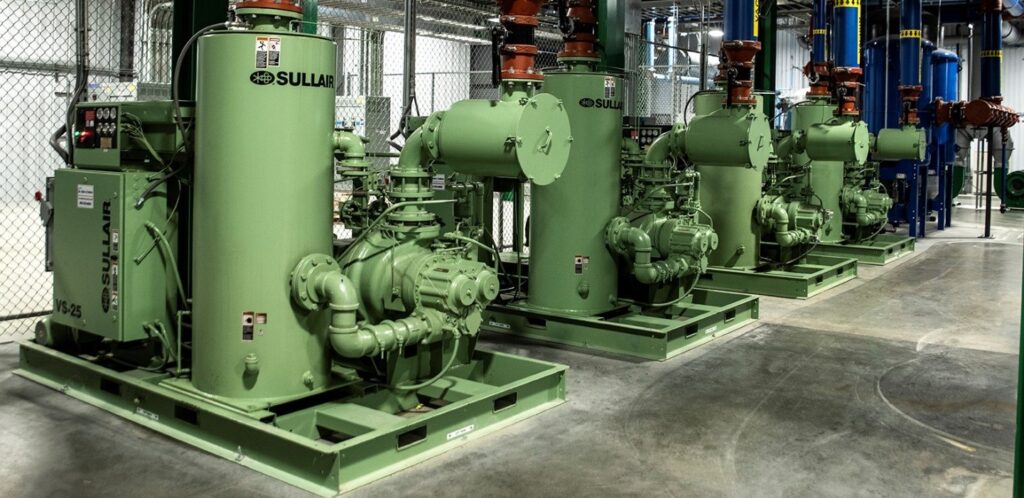
All information and answers provided by Mr. Dan Botts, a Blake & Pendleton partner, vacuum pump expert and author of Industrial Vacuum 101: The Basics of Vacuum Technology.
The applications of vacuum pump technology are countless; they include everything from medical suction in a surgical room to moving large masses of material throughout warehouses and manufacturing plants.
On a very basic level, your home vacuum operates in a similar way as an industrial vacuum pump. At the inlet, air is pulled into the vacuum, an at the outlet, air is discharged back into the surrounding atmosphere.
Okay, so an industrial pump is way more advanced than your home vacuum cleaner. But, similar to the vacuum varieties you see at your local retailer (think pet-hair specific vs. wet Shop Vac), industrial vacuum pumps come with an array of options; and the one you choose depends on the job you need it to do.
THE MOST COMMON INDUSTRIAL VACUUM PUMPS
Vacuum pumps are not one-size-fits-all and finding the correct fit requires recognizing your application needs. While your options are numerous, check out some of the most common industrial pumps used in facilities today:
Rotary Screw Vacuum Pump:
- used in: food processing, plastics, wood working, printing, hospitals
- ultimate vacuum level: 29.5” HgV to 29.9” HgV
- a modulating inlet valve or variable speed drive allows for air flow automation
- long life
Reciprocating Vacuum Pump:
- used in: printing, hospitals, gas well head evacuation
- can be oil sealed or dry
- lower efficiency as vacuum levels rise in single-acting piston pumps
- very high efficiency in double-acting piston pump but requires specialized foundation & engineering
Rotary Piston Vacuum Pump:
- used in: heat treating, semiconductor processing, plastics, food processing
- typically used at higher vacuum levels
- is durable for applications with small amount of particulate matter
- very long life; 20+ years
Rotary Vane Vacuum Pump:
- applications are in the thousands
- can be oil sealed or dry
- solid energy efficiencies with quiet operation
- sensitive to particulate matter
*Excerpts from Industrial Vacuum 101: The Basics of Vacuum Technology, Part One, Second Edition
 DOES HIGHER VACUUM EQUAL BETTER VACUUM?
DOES HIGHER VACUUM EQUAL BETTER VACUUM?
In the world of vacuum, bigger is not always better.
Operating a process at vacuum levels higher than required can increase your energy consumption and overall operating cost. Choosing the right vacuum level requires a close look at your application requirements. The best option for vacuum longevity and efficiency will be the pump system that matches your needs, not outdoes them. Note that one of the most common issues in vacuum systems is excessive pressure differential between vacuum pumps and process applications. This scenario will necessitate higher than required vacuum levels and could require larger vacuum pumps as a result.
DO I NEED A SPECIAL SET UP FOR DISCHARGED AIR?
The answer to this question depends on what is coming out of the pump.
If the pump is just discharging air, you may be able to discharge the pump exhaust directly into the room. If heat is an issue, vacuum pump exhaust should be piped outside for discharge.
Many oil-sealed vacuum pumps will have oil vapor entrained in the discharge air. Over time, there can be an accumulation of condensed oil on surrounding equipment or on facility roofs or walls if it is piped outside. In these cases, an oil mist exhaust filter is recommended to do a final cleaning on discharge air.
If there are chemicals, vapors or solvents that are being discharged, it is important to remove them before air is released to the environment.
I HAVE MULTIPLE VACUUM PUMPS – DO I NEED A CENTRAL CONTROL SYSTEM?
An automation package delivers optimized energy savings and simpler equipment management, hands down. Automation offers instant notifications on process vacuum levels, pump operation, pump failures and energy consumption.
Blake & Pendleton has automation that can integrate vacuum pumps, compressors, cooling water pumps, chillers and fans, all in one package.
There are many more things to consider when looking for a vacuum pump and a large variety of options available! To learn what technologies are a fit for your facility, contact Blake & Pendleton here.
Check out Dan Botts book for a more in-depth look at the basics of vacuum technology!


 DOES HIGHER VACUUM EQUAL BETTER VACUUM?
DOES HIGHER VACUUM EQUAL BETTER VACUUM?